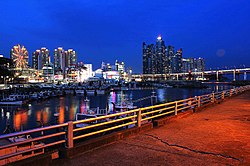Liu-Hu
Liu-Hu City | |
|---|---|
Clockwise from top: Skyline of Liu-Hu, Imperial Winter Palace, The International School of Liu-Hu, Port of Liu-Hu, Sacred Healer's Hospital, Downtown Liu-Hu | |
| Nickname: The Shining Jewel | |
| Country | Songha |
| Settled | ~120 BC |
| Government | |
| • Body | City Council of Liu-Hu |
| Population (2016) | 12,823,476 |
| Demonym | Liuhuan |
| Website | www.liuhucity.sg |
Liu Hu, officially Liu-Hu has been the Administrative Capital of Songha since 1622. Liu-Hu is on the Western Coast of Songha, at a central point for much of the national population center. It is the second largest city in Songha, and as the Administrative Capital, Ministry Buildings and Embassies are located here. As of the 2016 census, Liu-Hu has a population of 12,823,476.
History
Pre-1622
Evidence of permanent settlement in what is now Liu-Hu dates back to roughly 120 BC, when a small town known as Lunya appears among written records of the time. Originally a small fishing and farming settlement, Lunya's central and strategic position attracted much interest from the Kingdoms of the Warring Kingdoms Era, swapping hands multiple times, with each seeking to cement control over Central Songha with their possession of the town.
In 439 AD, the city would change hands for the last time in over a millenium, when the growing Seung Dynasty directly to the town's Southwest, captured the city from the waning Kingdom of Shui-T'ien. Upon the capture of the town, the Seung Dynasty renamed the city as Liu-Hu. Following its capture, the Shui-T'ien Kingdom was split in half, as the roads connecting it's Northern and Southern Realms ran directly through the Central area surrounding Liu-Hu.
In 1341, the City of Liu-Hu experienced wide and destructive fires, said by Songhese Mythology to have been a strike from the Gods themselves as a result of the straying of Songhans, and especially the Seung Dynasty, for their straying from their faith and from nature. Modern estimates by historians estimate that roughly 75% of Liu-Hu was destroyed upwards, and thousands of people lost their lives. The ensuing chaos brought riots and a near fracturing of Songha as the strategic position around Liu-Hu fell into a state of anarchy.
By 1374, much of Liu-hu had been rebuilt, and in the coming years as the Central Seung Dynasty relocated their center of power to the Bai'akisa Mountains, Liu-Hu came under the administration and influence of distant wings of the Seung Family, Merchants, and Mercenaries.
In 1593, the outbreak of Civil War in Songha began; the Western Wing of the Seung Family based in Liu-Hu fell in line behind Tarovecahe Giwas-Seung, who had spent a few years living in the city in her adolescence. This alliance provided much of the basis for the eventual victory of the Green Guard in the Sister's War, as they were able to solidify control across the Central Plains and the Bai'akisa Mountain Range within the first year of the war.
Six years after the end of the Sisters War, Songha was attacked by the Rythenean Navy; the Songhese Navy was wiped out within days, and within the first year, Rythene was able to establish control over much of the Western Songhese Coast, including Liu-Hu. Apart from sporadic clashes on the outskirts of Liu-Hu, the city remained firmly in the hands of Rythene until the signing of peace in 1620.
Following the war, Liu-Hu was nominally awarded to remain under Songhese control; however, Songhese forces were barred from the city, while Rythenean forces continued to de facto occupy the city for two centuries. The influence of the Western Seung Faction diminished as they were unable to project their control over their own city, let alone the surrounding area, and much of the Central Plains became infested with Banditry, while Pirates began roaming the Straits of Qes from villages on the Coast.
1622 - 1914
Following the Treaty of Liu-Hu, the city was declared as the Administrative Capital of Songha. Institutions such as the National Bank, Treasury, and Military Headquarters and more were moved here, under close supervision by the Rytheneans. This also gave the first semblence of any power to the Citizenry of Songha, particularly the Merchant and Mercenary Classes of Liu-Hu, who were able to wield significant influence in the city to affect policy.





